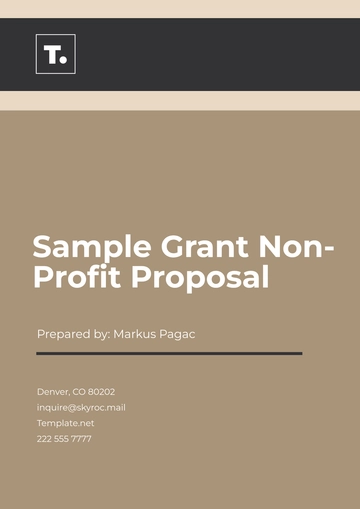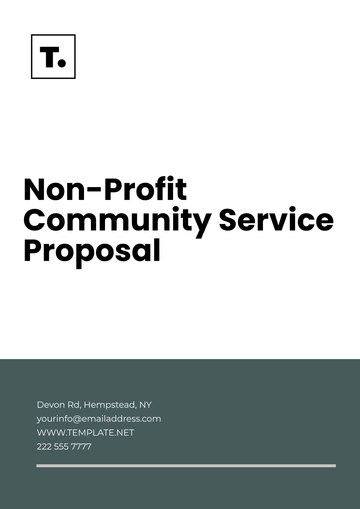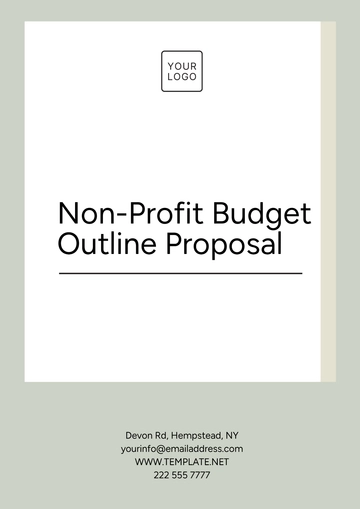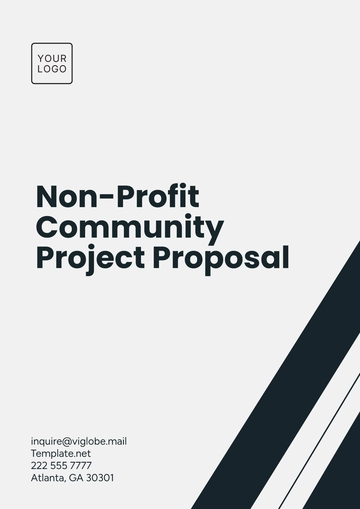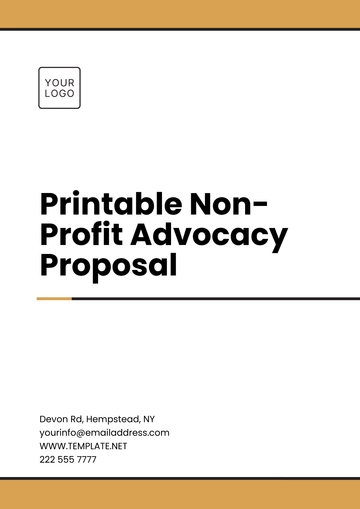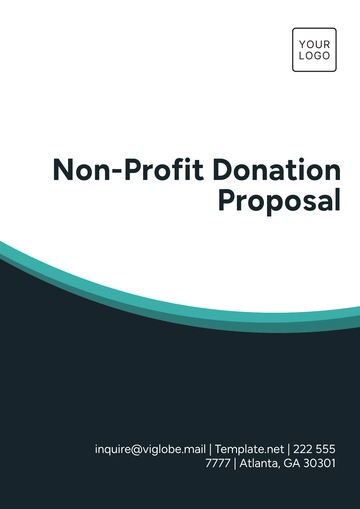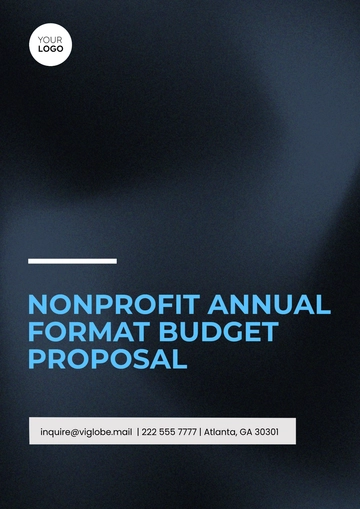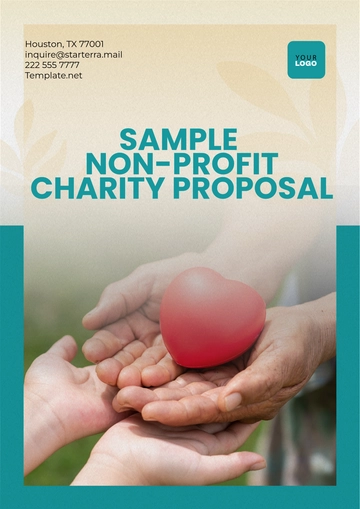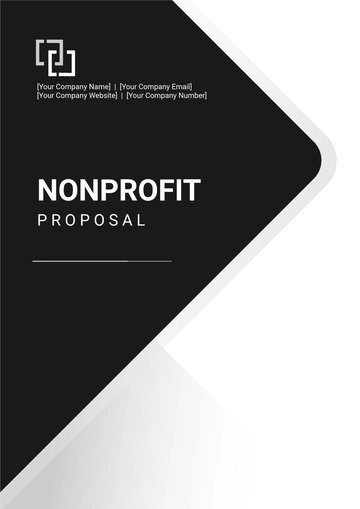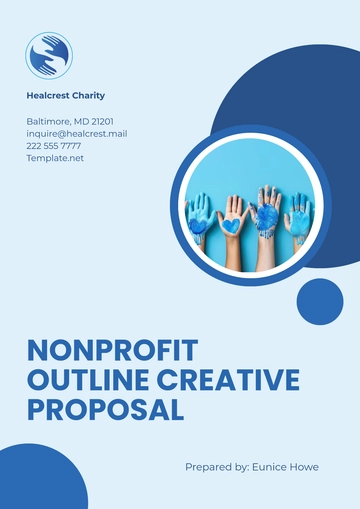Free Professional Church Community Outreach Proposal
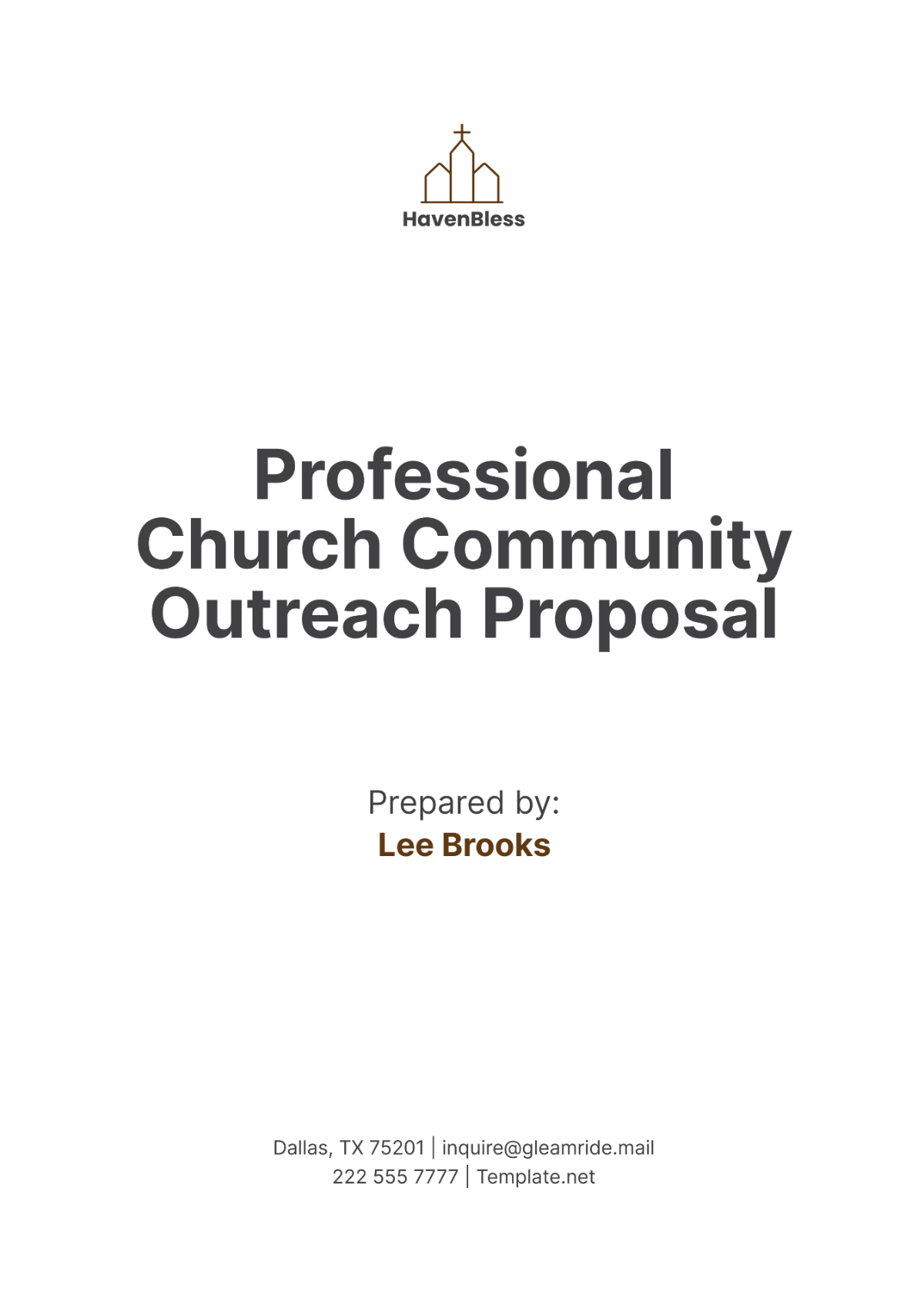
I. Executive Summary
The purpose of this Church Community Outreach Proposal is to outline a strategic plan for [Your Company Name] to expand its outreach efforts within the local community. The proposed initiatives aim to foster a sense of community, provide essential services, and support the spiritual and physical well-being of our neighbors. This proposal includes detailed plans for various outreach programs, a comprehensive budget, and a timeline for implementation.
The total budget for this outreach initiative is projected to be $50,000, which will cover program costs, materials, marketing, and staff stipends. The timeline for the implementation spans over one year, with quarterly reviews to assess progress and make necessary adjustments. This proposal highlights the need for community engagement, collaboration with local organizations, and effective communication strategies to ensure the success of our outreach programs.
By implementing this outreach initiative, [Your Company Name] aims to create lasting positive impacts in the community, address urgent needs, and build stronger relationships with our neighbors. Our goal is to demonstrate the love of Christ through practical acts of service and support, thereby fulfilling our mission to serve and uplift those around us.
II. Outreach Programs
A. Food Assistance Program
The Food Assistance Program aims to provide nutritious meals to families and individuals in need within our community.
Weekly Meal Distribution: Distribute meals to families every Friday evening. This will include hot meals and non-perishable food items to help sustain them through the weekend.
Partnership with Local Food Banks: Collaborate with local food banks to secure a steady supply of food items. This partnership will ensure that we have sufficient resources to meet the demand.
Volunteer Coordination: Recruit and train volunteers to assist with meal preparation, distribution, and delivery. Volunteers will play a crucial role in the success of this program.
Nutritional Education: Provide educational materials on nutrition and healthy eating habits to program participants. This will help them make informed choices about their diets.
B. After-School Tutoring Program
This program is designed to support students academically and provide a safe, productive environment after school hours.
Volunteer Tutors: Recruit volunteer tutors from the congregation and local colleges to provide academic assistance in various subjects. Tutors will offer personalized support to students based on their needs.
Homework Help Sessions: Organize daily homework help sessions to assist students with their assignments. These sessions will be held in the church’s community center.
Skill-Building Workshops: Offer workshops on study skills, time management, and test preparation. These workshops will equip students with essential academic skills.
Mentorship Program: Pair students with mentors who can provide guidance and support beyond academics. Mentors will help students set goals and navigate challenges.
C. Health and Wellness Clinic
The Health and Wellness Clinic will provide basic medical services and health education to community members.
Free Health Screenings: Offer free health screenings for blood pressure, cholesterol, and glucose levels. Screenings will be conducted by licensed healthcare professionals.
Health Education Workshops: Conduct workshops on topics such as nutrition, exercise, mental health, and chronic disease management. These workshops aim to promote overall well-being.
Partnership with Local Clinics: Collaborate with local clinics and healthcare providers to refer patients for follow-up care. Partnerships will ensure continuity of care for our community members.
Mobile Health Unit: Utilize a mobile health unit to reach underserved areas within the community. The mobile unit will provide health services to those who may not have access otherwise.
D. Job Training and Employment Assistance
This program focuses on helping community members acquire job skills and find employment opportunities.
Resume Writing Workshops: Offer workshops on resume writing and job application processes. Participants will learn how to create effective resumes and cover letters.
Interview Skills Training: Provide training sessions on interview skills and techniques. Participants will practice mock interviews and receive feedback from experienced professionals.
Job Fair Events: Host job fairs in collaboration with local businesses and employment agencies. Job fairs will connect job seekers with potential employers.
Ongoing Support and Counseling: Offer ongoing support and career counseling to help individuals navigate the job market. Counselors will provide guidance on career choices and professional development.
E. Community Fellowship Events
These events aim to build a sense of community and provide opportunities for fellowship and connection.
Monthly Community Dinners: Host monthly dinners open to all community members. These dinners will provide a space for fellowship and building relationships.
Seasonal Festivals: Organize seasonal festivals and celebrations to bring the community together. Festivals will include activities for all ages and promote a sense of unity.
Support Groups: Establish support groups for various needs, such as grief support, addiction recovery, and parenting. Support groups will offer a safe space for sharing and healing.
Youth Activities: Plan activities and outings specifically for the youth. These activities will provide positive, constructive experiences for young people.
F. Senior Support Services
This program focuses on addressing the needs of senior citizens in the community.
Home Visits: Organize regular home visits to check on seniors and provide companionship. Volunteers will offer support and assistance with daily tasks.
Transportation Services: Provide transportation services for seniors to attend medical appointments, grocery shopping, and church events. Reliable transportation will ensure seniors can maintain their independence.
Social Activities: Plan social activities and events specifically for seniors. Activities will include game nights, craft sessions, and exercise classes.
Resource Coordination: Help seniors access resources and services available to them. Coordinators will assist with navigating healthcare, housing, and financial assistance programs.
Each outreach program is designed to address specific needs within the community, from providing food and academic support to offering health services and job training. By leveraging partnerships with local organizations, recruiting dedicated volunteers, and providing comprehensive support, [Your Company Name] can make a significant positive impact on the lives of community members. These programs not only address immediate needs but also empower individuals with the tools and resources necessary for long-term success.
III. Budget
The following chart and table outline the detailed budget for each outreach program. The total budget for the outreach initiative is projected to be $50,000:
No. | Program | Budget Allocation | Description |
|---|---|---|---|
1 | Food Assistance Program | $10,000 | Meal distribution, food supplies, volunteer stipends |
2 | After-School Tutoring Program | $8,000 | Educational materials, tutor stipends, workshop costs |
3 | Health and Wellness Clinic | $12,000 | Medical supplies, mobile health unit, health education |
4 | Job Training and Employment Assistance | $7,000 | Workshop materials, job fair costs, counseling services |
5 | Community Fellowship Events | $6,000 | Event supplies, food, activity costs |
6 | Senior Support Services | $7,000 | Transportation, home visit supplies, social activities |
Total | $50,000 |
A. Food Assistance Program
Budget Allocation: $10,000 is allocated to the Food Assistance Program.
Meal Distribution: Funds will cover the cost of food supplies for weekly meal distributions.
Volunteer Stipends: Stipends for volunteers who assist with meal preparation and distribution will be included.
Partnerships: Collaborations with local food banks will provide additional resources.
B. After-School Tutoring Program
Budget Allocation: $8,000 is allocated to the After-School Tutoring Program.
Educational Materials: Funds will be used to purchase books, supplies, and other educational materials.
Tutor Stipends: Stipends for volunteer tutors will be provided.
Workshops: Costs for organizing skill-building workshops will be covered.
C. Health and Wellness Clinic
Budget Allocation: $12,000 is allocated to the Health and Wellness Clinic.
Medical Supplies: Funds will cover the purchase of medical supplies for health screenings.
Mobile Health Unit: Expenses for operating the mobile health unit will be included.
Health Education: Costs for conducting health education workshops will be covered.
D. Job Training and Employment Assistance
Budget Allocation: $7,000 is allocated to the Job Training and Employment Assistance Program.
Workshop Materials: Funds will cover the cost of materials for resume writing and interview skills workshops.
Job Fairs: Expenses for hosting job fair events will be included.
Career Counseling: Costs for providing ongoing career counseling services will be covered.
E. Community Fellowship Events
Budget Allocation: $6,000 is allocated to Community Fellowship Events.
Event Supplies: Funds will cover the cost of supplies for community dinners and seasonal festivals.
Food: Expenses for providing food at events will be included.
Activities: Costs for organizing activities for all ages will be covered.
F. Senior Support Services
Budget Allocation: $7,000 is allocated to Senior Support Services.
Transportation Services: Funds will cover the cost of providing transportation for seniors.
Home Visits: Expenses for supplies needed during home visits will be included.
Social Activities: Costs for planning and organizing social activities for seniors will be covered.
The budget allocation for each program ensures that sufficient resources are available to implement the outreach initiatives effectively. By strategically distributing funds, [Your Company Name] can address various community needs and maximize the impact of each program. The financial support for volunteers, educational materials, medical supplies, and event planning will ensure that all aspects of the outreach programs are well-supported and sustainable.
IV. Implementation Timeline
The implementation timeline outlines the key milestones and deadlines for each outreach program. The timeline spans over one year, with quarterly reviews to assess progress and make necessary adjustments. The following table provides a detailed timeline for the implementation of the outreach programs:
No. | Quarter | Key Activities |
|---|---|---|
1 | First Quarter | Program planning, volunteer recruitment, initial marketing |
2 | Second Quarter | Program launch, health screenings, job training workshops |
3 | Third Quarter | Community events, mobile health unit deployment, job fairs |
4 | Fourth Quarter | Senior support services, program evaluation, year-end review |
A. First Quarter (Q1)
Program Planning: Finalize plans for all outreach programs and secure partnerships with local organizations. Detailed planning will ensure each program is well-organized and effective.
Volunteer Recruitment: Begin recruiting and training volunteers for each program. A dedicated team of volunteers is essential for successful implementation.
Initial Marketing: Launch marketing campaigns to raise awareness about the outreach initiatives. Effective marketing will engage the community and encourage participation.
B. Second Quarter (Q2)
Program Launch: Launch the Food Assistance Program and After-School Tutoring Program. These programs will address immediate community needs.
Health Screenings: Begin offering free health screenings through the Health and Wellness Clinic. Regular screenings will promote community health and well-being.
Job Training Workshops: Start conducting resume writing and interview skills workshops. These workshops will help individuals improve their job prospects.
C. Third Quarter (Q3)
Community Events: Host the first community dinner and seasonal festival. These events will foster community spirit and provide opportunities for fellowship.
Mobile Health Unit: Deploy the mobile health unit to underserved areas. The mobile unit will ensure that health services are accessible to all.
Job Fairs: Organize the first job fair event. Job fairs will connect job seekers with potential employers and employment opportunities.
D. Fourth Quarter (Q4)
Senior Support Services: Begin providing transportation services and home visits for seniors. These services will help seniors maintain their independence and well-being.
Program Evaluation: Conduct evaluations of each program to assess effectiveness and gather feedback. Evaluations will inform future improvements and adjustments.
Year-End Review: Hold a year-end review meeting to discuss progress, challenges, and plans for the following year. The review will provide an opportunity for reflection and strategic planning.
The implementation timeline provides a clear roadmap for rolling out the outreach programs. By staggering the launch of each program and conducting regular reviews, [Your Company Name] can ensure that each initiative is effectively managed and adjusted as needed. This phased approach allows for thorough planning, effective volunteer training, and continuous improvement based on feedback and evaluation results.
V. Marketing and Communication
Effective marketing and communication strategies are essential to raise awareness about the outreach programs and engage the community.
A. Marketing Channels
Social Media: Utilize social media platforms to promote the outreach programs and share updates. Regular posts, event pages, and live streams will engage the community.
Church Bulletin: Include information about the outreach programs in the church bulletin and newsletter. This will keep the congregation informed and involved.
Local Media: Partner with local newspapers, radio stations, and TV channels to publicize the outreach initiatives. Press releases and interviews will reach a broader audience.
Community Flyers: Distribute flyers and posters in key locations around the community. These materials will provide detailed information about the programs and how to participate.
B. Community Engagement
Town Hall Meetings: Host town hall meetings to discuss the outreach programs and gather input from community members. These meetings will foster a sense of involvement and ownership.
Focus Groups: Conduct focus groups with different segments of the community to gather feedback and tailor the programs to meet their needs.
Volunteer Appreciation Events: Organize events to recognize and appreciate the contributions of volunteers. This will boost morale and encourage continued participation.
Collaborative Partnerships: Work closely with local organizations, schools, and businesses to promote the outreach programs and expand their reach.
C. Digital Presence
Website Updates: Regularly update the church’s website with information about the outreach programs, upcoming events, and volunteer opportunities.
Email Campaigns: Send out regular email campaigns to keep the community informed about program developments and success stories.
Online Registrations: Provide online registration forms for program participants and volunteers. This will streamline the sign-up process and improve accessibility.
Virtual Events: Host virtual events and webinars to reach a wider audience and provide information about the outreach programs.
A comprehensive marketing and communication strategy ensures that the outreach programs reach the intended audience and garner the necessary support. By leveraging multiple marketing channels, engaging the community through various events, and maintaining a strong digital presence, [Your Company Name] can effectively promote its outreach initiatives. These efforts will help build awareness, encourage participation, and foster a sense of community involvement.
VI. Key Performance Indicators (KPIs)
To measure the success of the outreach programs, the following Key Performance Indicators (KPIs) will be tracked:
No. | KPI | Target |
|---|---|---|
1 | Number of Meals Distributed | 500 per month |
2 | Student Participation in Tutoring | 50 students per quarter |
3 | Health Screenings Conducted | 100 per quarter |
4 | Job Placement Rate | 20% increase |
5 | Attendance at Community Events | 200 attendees per event |
6 | Senior Support Service Utilization | 70% utilization rate |
A. Meal Distribution
Tracking System: Implement a system to track the number of meals distributed each week. This will provide data on the reach and impact of the Food Assistance Program.
Monthly Reports: Generate monthly reports to monitor progress and identify trends. These reports will help in assessing the program’s effectiveness.
Feedback Collection: Collect feedback from program participants to understand their needs and satisfaction levels. This will inform any necessary adjustments to the program.
Volunteer Input: Gather input from volunteers on the distribution process and areas for improvement. This will ensure the program runs smoothly and efficiently.
B. Student Participation
Attendance Logs: Maintain detailed attendance logs for tutoring sessions. This will help track student participation and engagement.
Academic Progress: Monitor the academic progress of participating students through regular assessments. This will provide insights into the program’s impact on their performance.
Parental Feedback: Collect feedback from parents on the effectiveness of the tutoring program. This will help identify strengths and areas for improvement.
Tutor Evaluations: Conduct regular evaluations of volunteer tutors to ensure they are meeting the needs of students. This will maintain the quality of tutoring services.
C. Health Screenings
Screening Records: Keep detailed records of all health screenings conducted. This will help track the reach and impact of the Health and Wellness Clinic.
Follow-Up Care: Monitor the follow-up care provided to individuals identified with health issues. This will ensure continuity of care and support.
Workshop Attendance: Track attendance at health education workshops. This will provide data on community engagement and interest in health topics.
Participant Feedback: Collect feedback from screening participants to gauge satisfaction and areas for improvement. This will inform future clinic activities.
D. Job Placement
Placement Records: Maintain records of job placements among program participants. This will track the success rate of the Job Training and Employment Assistance Program.
Employer Feedback: Gather feedback from employers on the preparedness and performance of placed individuals. This will help improve training and support services.
Participant Follow-Up: Conduct follow-up interviews with placed individuals to understand their experiences and ongoing needs. This will provide insights into the program’s long-term impact.
Program Adjustments: Use data and feedback to make necessary adjustments to the job training and placement process. This will enhance the program’s effectiveness.
E. Community Event Attendance
Registration Forms: Use registration forms to track attendance at community events. This will provide data on community engagement and interest.
Event Feedback: Collect feedback from event attendees to understand their experiences and satisfaction levels. This will help improve future events.
Volunteer Input: Gather input from volunteers on the planning and execution of events. This will ensure events are well-organized and meet community needs.
Event Reports: Generate reports on each event’s attendance, activities, and outcomes. These reports will inform future event planning.
F. Senior Support Service Utilization
Service Logs: Maintain detailed logs of transportation and home visit services provided. This will track the utilization rate of senior support services.
Senior Feedback: Collect feedback from seniors on the services they receive. This will help identify strengths and areas for improvement.
Volunteer Reports: Gather reports from volunteers on their experiences and observations during home visits. This will provide insights into the needs of seniors.
Program Adjustments: Use data and feedback to make necessary adjustments to the senior support services. This will enhance the program’s effectiveness.
Tracking these KPIs will provide valuable insights into the effectiveness of the outreach programs. By regularly monitoring progress and gathering feedback, [Your Company Name] can make data-driven decisions to improve and expand its outreach efforts. These KPIs will help ensure that the programs are meeting their goals and making a meaningful impact in the community.
VII. Partnerships and Collaboration
Collaboration with local organizations and stakeholders is essential for the success of the outreach programs.
A. Local Food Banks
Resource Sharing: Partner with local food banks to share resources and expand the reach of the Food Assistance Program.
Joint Events: Organize joint events and food drives to raise awareness and increase community engagement.
Volunteer Exchange: Coordinate volunteer efforts between the church and food banks to maximize impact and efficiency.
Feedback Mechanism: Establish a feedback mechanism to gather input from both organizations and program participants. This will help improve collaboration and service delivery.
B. Schools and Educational Institutions
Student Recruitment: Collaborate with local schools to recruit students for the After-School Tutoring Program.
Resource Sharing: Share educational resources and materials with schools to support student learning.
Joint Workshops: Organize joint workshops and seminars on educational topics to benefit students and parents.
Feedback Mechanism: Establish a feedback mechanism to gather input from schools, students, and parents. This will help improve the tutoring program.
C. Healthcare Providers
Health Screenings: Partner with local clinics and healthcare providers to offer health screenings and follow-up care.
Health Education: Collaborate on health education workshops to promote community well-being.
Resource Sharing: Share medical supplies and resources to support the Health and Wellness Clinic.
Feedback Mechanism: Establish a feedback mechanism to gather input from healthcare providers and clinic participants. This will help improve health services.
D. Local Businesses
Job Fairs: Partner with local businesses to organize job fairs and employment workshops.
Resource Sharing: Share resources and expertise to support job training and placement efforts.
Joint Events: Organize joint events and initiatives to promote community engagement and economic development.
Feedback Mechanism: Establish a feedback mechanism to gather input from businesses and job seekers. This will help improve job training and placement services.
E. Community Organizations
Event Collaboration: Partner with community organizations to plan and execute community fellowship events.
Resource Sharing: Share resources and expertise to support event planning and execution.
Joint Initiatives: Organize joint initiatives and programs to address community needs and foster collaboration.
Feedback Mechanism: Establish a feedback mechanism to gather input from community organizations and event participants. This will help improve event planning and execution.
F. Senior Services Agencies
Service Coordination: Collaborate with senior services agencies to coordinate transportation and home visit services.
Resource Sharing: Share resources and expertise to support senior support services.
Joint Workshops: Organize joint workshops and activities for seniors to promote well-being and social engagement.
Feedback Mechanism: Establish a feedback mechanism to gather input from senior services agencies and program participants. This will help improve senior support services.
Partnerships and collaboration with local organizations are crucial for the success of the outreach programs. By leveraging the strengths and resources of each partner, [Your Company Name] can enhance its outreach efforts and provide comprehensive support to the community. These partnerships will also foster a sense of unity and cooperation, ensuring that the programs are sustainable and impactful.
VIII. Risk and Mitigation
Identifying potential risks and implementing mitigation strategies is essential to ensure the success of the outreach programs.
A. Funding Shortfalls
Diversified Funding Sources: Seek funding from multiple sources, including grants, donations, and fundraising events. Diversified funding will reduce reliance on a single source.
Budget Adjustments: Develop a flexible budget that can be adjusted based on available funds. This will ensure that critical programs can continue even with limited resources.
Emergency Fund: Establish an emergency fund to cover unexpected expenses and funding shortfalls. This will provide a financial safety net for the programs.
Regular Financial Reviews: Conduct regular financial reviews to monitor budget performance and identify potential shortfalls early. This will allow for timely adjustments and corrective actions.
B. Volunteer Availability
Ongoing Recruitment: Maintain an ongoing volunteer recruitment campaign to ensure a steady supply of volunteers. This will address fluctuations in volunteer availability.
Volunteer Retention: Implement strategies to retain volunteers, such as recognition programs, training opportunities, and regular communication. Retention efforts will maintain a dedicated volunteer base.
Flexible Scheduling: Offer flexible scheduling options to accommodate volunteers’ availability. This will make it easier for individuals to participate.
Backup Plans: Develop backup plans to address potential volunteer shortages. This may include cross-training staff and identifying alternative resources.
C. Community Engagement
Effective Communication: Implement a comprehensive communication strategy to raise awareness about the programs. Clear and consistent communication will engage the community.
Inclusive Approach: Ensure that programs are inclusive and accessible to all community members. An inclusive approach will increase participation and support.
Feedback Mechanism: Establish a feedback mechanism to gather input from the community. This will help identify and address any barriers to engagement.
Collaborative Partnerships: Work closely with local organizations to promote the programs and reach a wider audience. Collaborative efforts will enhance community engagement.
D. Program Effectiveness
Regular Evaluations: Conduct regular evaluations of each program to assess effectiveness and gather feedback. Evaluations will inform improvements and adjustments.
Data-Driven Decisions: Use data and feedback to make informed decisions about program planning and implementation. Data-driven decisions will enhance program effectiveness.
Continuous Improvement: Implement a continuous improvement process to regularly review and enhance programs. This will ensure that programs remain relevant and impactful.
Stakeholder Involvement: Involve stakeholders in program planning and evaluation. Stakeholder involvement will provide valuable insights and support.
E. Health and Safety
Health Protocols: Implement health and safety protocols for all programs, including hygiene practices and social distancing. This will ensure the well-being of participants and volunteers.
Emergency Preparedness: Develop emergency preparedness plans to address potential health and safety incidents. Preparedness plans will ensure a quick and effective response.
Regular Training: Provide regular training for staff and volunteers on health and safety practices. Training will ensure that everyone is equipped to handle potential risks.
Risk Assessments: Conduct regular risk assessments to identify and mitigate potential health and safety hazards. Risk assessments will help create a safe environment for all.
By identifying potential risks and implementing mitigation strategies, [Your Company Name] can ensure the success and sustainability of the outreach programs. Proactive risk management will address potential challenges and ensure that the programs can continue to serve the community effectively.
IX. Conclusion
This Church Community Outreach Proposal outlines a comprehensive plan for [Your Company Name] to expand its outreach efforts and make a meaningful impact in the community. By implementing various programs such as the Food Assistance Program, After-School Tutoring Program, Health and Wellness Clinic, Job Training and Employment Assistance, Community Fellowship Events, and Senior Support Services, we can address urgent needs and provide essential support to those in need.
The detailed budget, implementation timeline, marketing and communication strategies, and KPIs ensure that the programs are well-planned, effectively executed, and continuously improved. Partnerships with local organizations and proactive risk management further enhance the sustainability and impact of the outreach initiatives.
By committing to these outreach efforts, [Your Company Name] will fulfill its mission to serve and uplift the community, demonstrating the love of Christ through practical acts of service and support. Together, we can build a stronger, more connected, and resilient community.
- 100% Customizable, free editor
- Access 1 Million+ Templates, photo’s & graphics
- Download or share as a template
- Click and replace photos, graphics, text, backgrounds
- Resize, crop, AI write & more
- Access advanced editor
Expand your outreach efforts with the Professional Church Community Outreach Proposal Template! This editable and customizable outreach proposal only available on Template.net enables you to draft a comprehensive outreach plan. The AI Editor Tool helps in creating a detailed and impactful proposal that can mobilize your congregation for community service!
You may also like
- Business Proposal
- Research Proposal
- Proposal Request
- Project Proposal
- Grant Proposal
- Photography Proposal
- Job Proposal
- Budget Proposal
- Marketing Proposal
- Branding Proposal
- Advertising Proposal
- Sales Proposal
- Startup Proposal
- Event Proposal
- Creative Proposal
- Restaurant Proposal
- Blank Proposal
- One Page Proposal
- Proposal Report
- IT Proposal
- Non Profit Proposal
- Training Proposal
- Construction Proposal
- School Proposal
- Cleaning Proposal
- Contract Proposal
- HR Proposal
- Travel Agency Proposal
- Small Business Proposal
- Investment Proposal
- Bid Proposal
- Retail Business Proposal
- Sponsorship Proposal
- Academic Proposal
- Partnership Proposal
- Work Proposal
- Agency Proposal
- University Proposal
- Accounting Proposal
- Real Estate Proposal
- Hotel Proposal
- Product Proposal
- Advertising Agency Proposal
- Development Proposal
- Loan Proposal
- Website Proposal
- Nursing Home Proposal
- Financial Proposal
- Salon Proposal
- Freelancer Proposal
- Funding Proposal
- Work from Home Proposal
- Company Proposal
- Consulting Proposal
- Educational Proposal
- Construction Bid Proposal
- Interior Design Proposal
- New Product Proposal
- Sports Proposal
- Corporate Proposal
- Food Proposal
- Property Proposal
- Maintenance Proposal
- Purchase Proposal
- Rental Proposal
- Recruitment Proposal
- Social Media Proposal
- Travel Proposal
- Trip Proposal
- Software Proposal
- Conference Proposal
- Graphic Design Proposal
- Law Firm Proposal
- Medical Proposal
- Music Proposal
- Pricing Proposal
- SEO Proposal
- Strategy Proposal
- Technical Proposal
- Coaching Proposal
- Ecommerce Proposal
- Fundraising Proposal
- Landscaping Proposal
- Charity Proposal
- Contractor Proposal
- Exhibition Proposal
- Art Proposal
- Mobile Proposal
- Equipment Proposal
- Student Proposal
- Engineering Proposal
- Business Proposal


